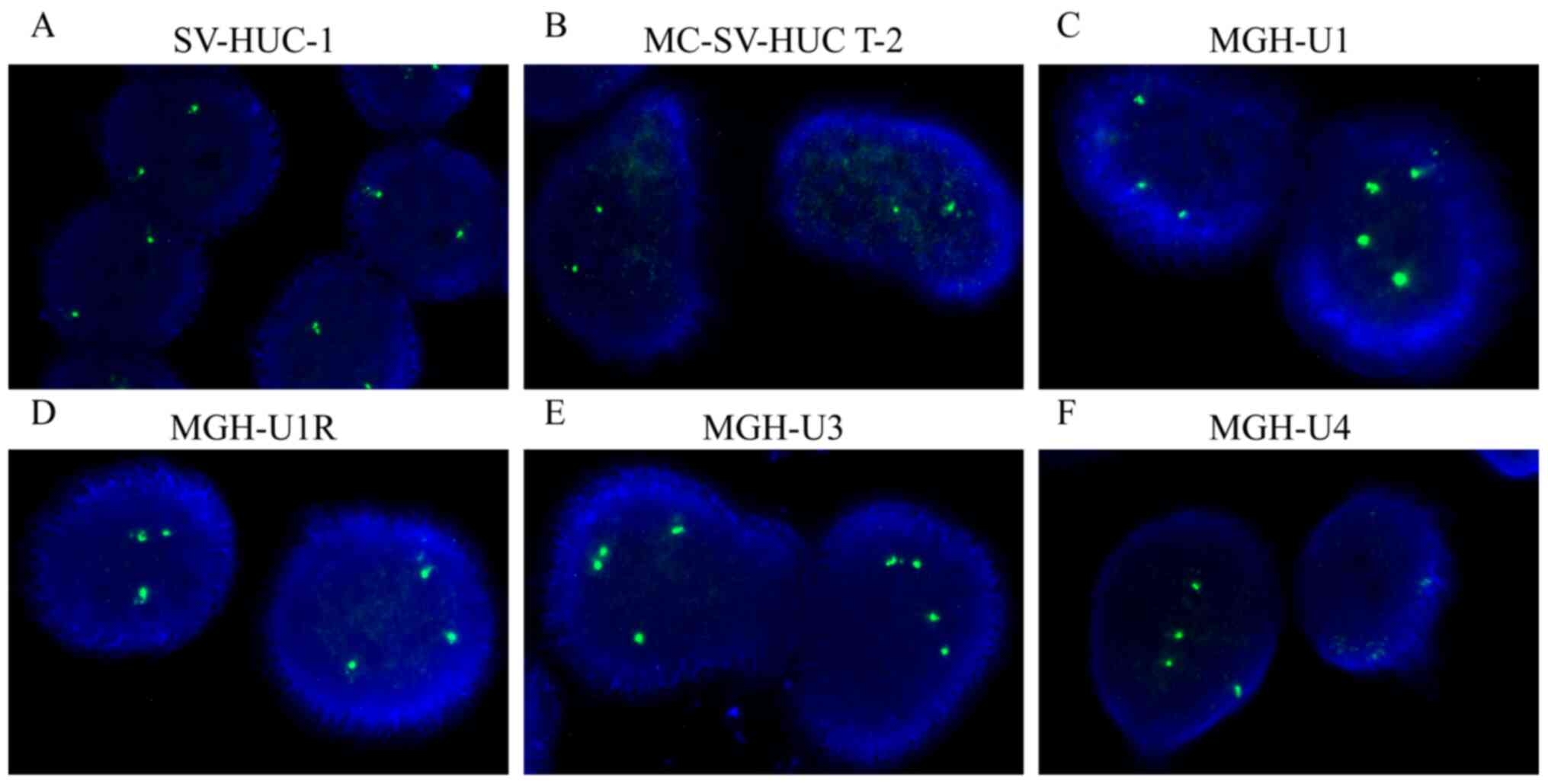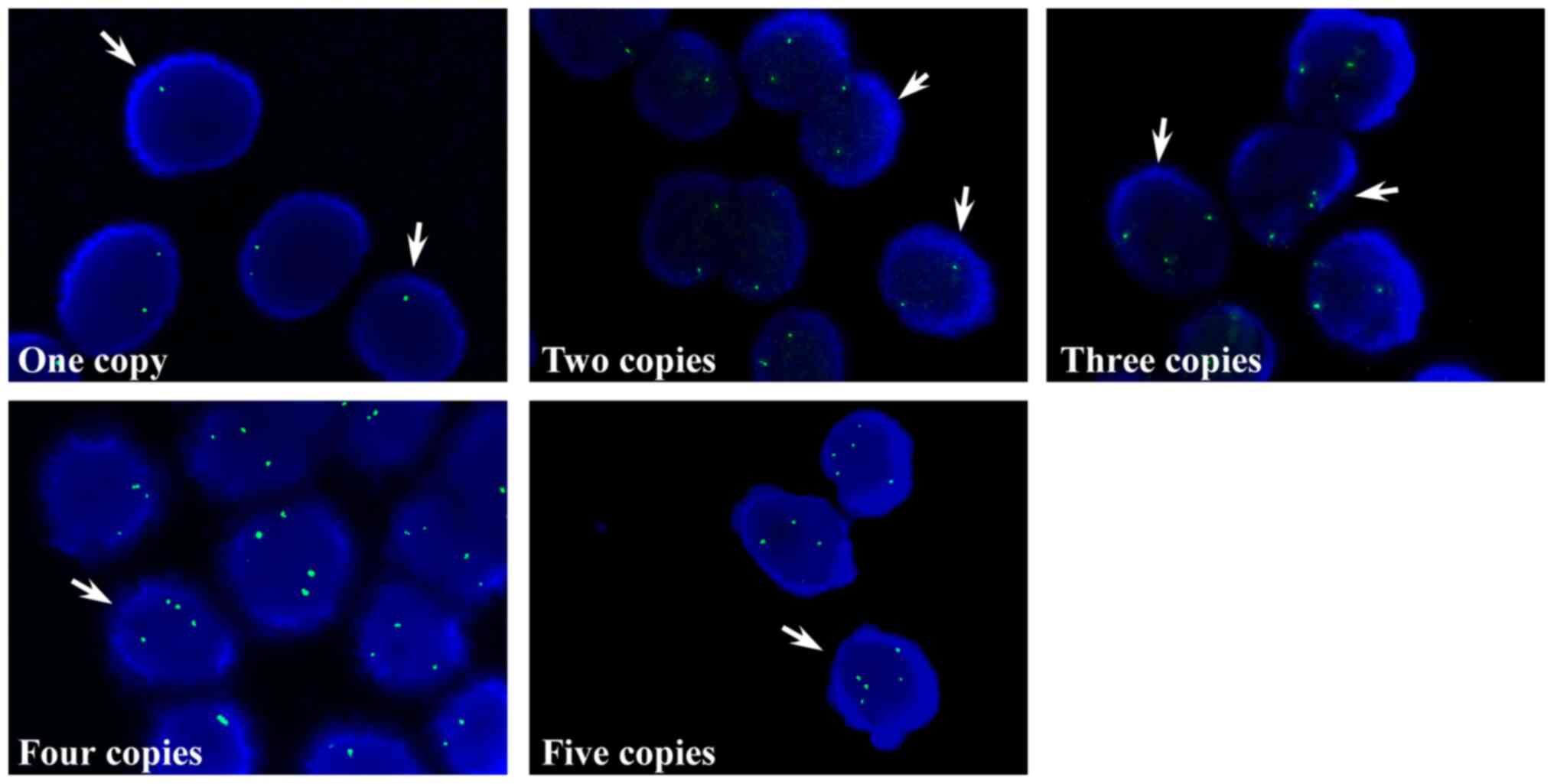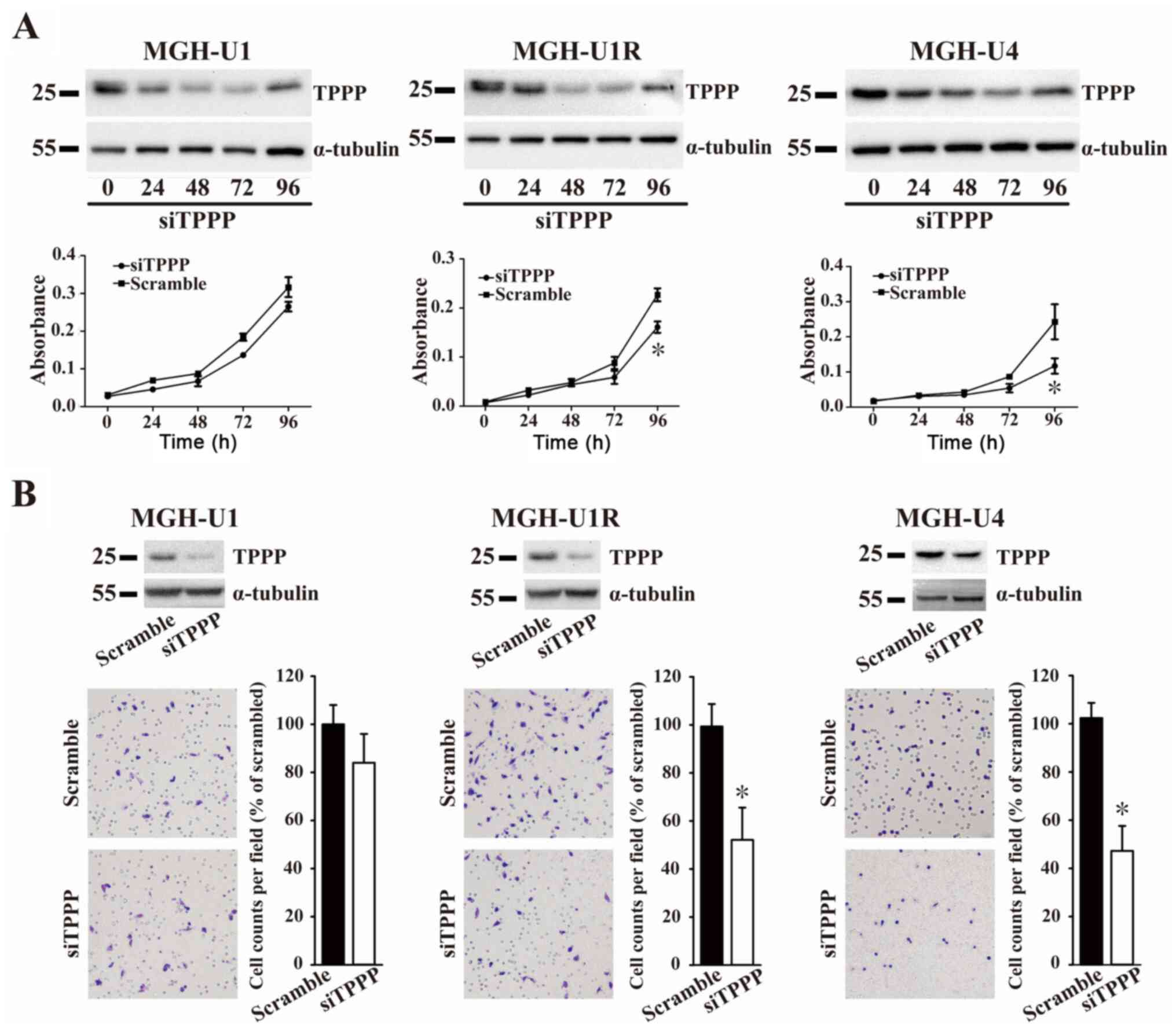|
1
|
Siegel RL, Miller KD and Jemal A: Cancer
statistics, 2019. CA Cancer J Clin. 69:7–34. 2019.PubMed/NCBI View Article : Google Scholar
|
|
2
|
Polo A, Crispo A, Cerino P, Falzone L,
Candido S, Giudice A, De Petro G, Ciliberto G, Montella M, Budillon
A and Costantini S: Environment and bladder cancer: Molecular
analysis by interaction networks. Oncotarget. 8:65240–65252.
2017.PubMed/NCBI View Article : Google Scholar
|
|
3
|
Goebell PJ and Knowles MA: Bladder cancer
or bladder cancers? Genetically distinct malignant conditions of
the urothelium. Urol Oncol. 28:409–428. 2010.PubMed/NCBI View Article : Google Scholar
|
|
4
|
Sanguedolce F, Bufo P, Carrieri G and
Cormio L: Predictive markers in bladder cancer: Do we have
molecular markers ready for clinical use? Crit Rev Clin Lab Sci.
51:291–304. 2014.PubMed/NCBI View Article : Google Scholar
|
|
5
|
Hernández S, López-Knowles E, Lloreta J,
Kogevinas M, Amorós A, Tardón A, Carrato A, Serra C, Malats N and
Real FX: Prospective study of FGFR3 mutations as a prognostic
factor in nonmuscle invasive urothelial bladder carcinomas. J Clin
Oncol. 24:3664–3671. 2006.PubMed/NCBI View Article : Google Scholar
|
|
6
|
Lamy A, Gobet F, Laurent M, Blanchard F,
Varin C, Moulin C, Andreou A, Frebourg T and Pfister C: Molecular
profiling of bladder tumors based on the detection of FGFR3 and
TP53 mutations. J Urol. 176:2686–2689. 2006.PubMed/NCBI View Article : Google Scholar
|
|
7
|
Lopez-Knowles E, Hernández S, Kogevinas M,
Lloreta J, Amorós A, Tardón A, Carrato A, Kishore S, Serra C,
Malats N, et al: The p53 pathway and outcome among patients with
T1G3 bladder tumors. Clin Cancer Res. 12:6029–6036. 2006.PubMed/NCBI View Article : Google Scholar
|
|
8
|
Dominguez G, Carballido J, Silva J, Silva
JM, García JM, Menéndez J, Provencio M, España P and Bonilla F:
p14ARF promoter hypermethylation in plasma DNA as an indicator of
disease recurrence in bladder cancer patients. Clin Cancer Res.
8:980–985. 2002.PubMed/NCBI
|
|
9
|
Brown FM: Urine cytology. It is still the
gold standard for screening? Urol Clin North Am. 27:25–37.
2000.PubMed/NCBI View Article : Google Scholar
|
|
10
|
Chuang KL, Chuang HC, Ng KF, Chang YH, Wu
CT, Chuang CK, Liao SK and Pang ST: Urinary fluorescence in situ
hybridization assay for detecting urothelial carcinoma in Taiwanese
patients. BJU Int. 105:1413–1416. 2010.PubMed/NCBI View Article : Google Scholar
|
|
11
|
Mischinger J, Guttenberg LP, Hennenlotter
J, Gakis G, Aufderklamm S, Rausch S, Neumann E, Bedke J, Kruck S,
Schwentner C, et al: Comparison of different concepts for
interpretation of chromosomal aberrations in urothelial cells
detected by fluorescence in situ hybridization. J Cancer Res Clin
Oncol. 143:677–685. 2017.PubMed/NCBI View Article : Google Scholar
|
|
12
|
Molitor M, Junker K, Eltze E, Toma M,
Denzinger S, Siegert S, Knuechel R and Gaisa NT: Comparison of
structural genetics of non-schistosoma-associated squamous cell
carcinoma of the urinary bladder. Int J Clin Exp Pathol.
8:8143–8158. 2015.PubMed/NCBI
|
|
13
|
Moktefi A, Pouessel D, Liu J, Sirab N,
Maille P, Soyeux P, Bergman CC, Auriault ML, Vordos D, Taille A, et
al: Reappraisal of HER2 status in the spectrum of advanced
urothelial carcinoma: A need of guidelines for treatment
eligibility. Mod Pathol. 31:1270–1281. 2018.PubMed/NCBI View Article : Google Scholar
|
|
14
|
Lengauer C, Kinzler KW and Vogelstein B:
Genetic instabilities in human cancers. Nature. 396:643–649.
1998.PubMed/NCBI View
Article : Google Scholar
|
|
15
|
Hanahan D and Weinberg RA: The hallmarks
of cancer. Cell. 100:57–70. 2000.PubMed/NCBI View Article : Google Scholar
|
|
16
|
Wu CF, Pang ST, Shee JJ, Chang PL, Chuang
CK, Chen CS, Liao SK and Weng WH: Identification of genetic
alterations in upper urinary tract urothelial carcinoma in
end-stage renal disease patients. Genes Chromosomes Cancer.
49:928–934. 2010.PubMed/NCBI View Article : Google Scholar
|
|
17
|
Yamamoto Y, Chochi Y, Matsuyama H, Eguchi
S, Kawauchi S, Furuya T, Oga A, Kang JJ, Naito K and Sasaki K: Gain
of 5p15.33 is associated with progression of bladder cancer.
Oncology. 72:132–138. 2007.PubMed/NCBI View Article : Google Scholar
|
|
18
|
Kang JU, Koo SH, Kwon KC, Park JW and Kim
JM: Gain at chromosomal region 5p15.33, containing TERT, is the
most frequent genetic event in early stages of non-small cell lung
cancer. Cancer Genet Cytogenetics. 182:1–11. 2008.PubMed/NCBI View Article : Google Scholar
|
|
19
|
Takahashi M, Tomizawa K, Fujita SC, Sato
K, Uchida T and Imahori K: A brain-specific protein p25 is
localized and associated with oligodendrocytes, neuropil, and
fiber-like structures of the CA3 hippocampal region in the rat
brain. J Neurochem. 60:228–235. 1993.PubMed/NCBI View Article : Google Scholar
|
|
20
|
Kovács GG, László L, Kovács J, Jensen PH,
Lindersson E, Botond G, Molnár T, Perczel A, Hudecz F, Mezo G, et
al: Natively unfolded tubulin polymerization promoting protein
TPPP/p25 is a common marker of alpha-synucleinopathies. Neurobiol
Dis. 17:155–162. 2004.PubMed/NCBI View Article : Google Scholar
|
|
21
|
Hlavanda E, Kovacs J, Olah J, Orosz F,
Medzihradszky KF and Ovadi J: Brain-specific p25 protein binds to
tubulin and microtubules and induces aberrant microtubule
assemblies at substoichiometric concentrations. Biochemistry.
41:8657–8664. 2002.PubMed/NCBI View Article : Google Scholar
|
|
22
|
Acevedo K, Li R, Soo P, Suryadinata R,
Sarcevic B, Valova VA, Graham ME, Robinson PJ and Bernard O: The
phosphorylation of p25/TPPP by LIM kinase 1 inhibits its ability to
assemble microtubules. Exp Cell Res. 313:4091–4106. 2007.PubMed/NCBI View Article : Google Scholar
|
|
23
|
Hlavanda E, Klement E, Kókai E, Kovács J,
Vincze O, Tökési N, Orosz F, Medzihradszky KF, Dombrádi V and Ovádi
J: Phosphorylation blocks the activity of tubulin
polymerization-promoting protein (TPPP): Identification of sites
targeted by different kinases. J Biol Chem. 282:29531–29539.
2007.PubMed/NCBI View Article : Google Scholar
|
|
24
|
Tirian L, Hlavanda E, Oláh J, Horváth I,
Orosz F, Szabó B, Kovács J, Szabad J and Ovádi J: TPPP/p25 promotes
tubulin assemblies and blocks mitotic spindle formation. Proc Natl
Acad Sci USA. 100:13976–13981. 2003.PubMed/NCBI View Article : Google Scholar
|
|
25
|
Zotter A, Bodor A, Olah J, Hlavanda E,
Orosz F, Perczel A and Ovádi J: Disordered TPPP/p25 binds GTP and
displays Mg2+-dependent GTPase activity. FEBS Lett. 585:803–808.
2011.PubMed/NCBI View Article : Google Scholar
|
|
26
|
Inokawa Y, Sonohara F, Kanda M, Hayashi M,
Nishikawa Y, Sugimoto H, Kodera Y and Nomoto S: Correlation between
poor prognosis and lower TPPP gene expression in hepatocellular
carcinoma. Anticancer Res. 36:4639–4645. 2016.PubMed/NCBI View Article : Google Scholar
|
|
27
|
Edge SB and Edge SB: AJCC Cancer Staging
Manual, 8th edition. Springer, 2017.
|
|
28
|
Chuang CK, Pang ST, Chuang TJ and Liao SK:
Profiling of matrix metalloproteinases and tissue inhibitors of
metalloproteinases proteins in bladder urothelial carcinoma. Oncol
Lett. 1:691–695. 2010.PubMed/NCBI View Article : Google Scholar
|
|
29
|
Kato T, Ishikawa K and Nemoto R:
Morphologic characterization of two established cell lines, T24 and
MGH-U1, derived from human bladder carcinoma (author's transl).
Nihon Hinyokika Gakkai Zasshi. 69(40)1978.PubMed/NCBI View Article : Google Scholar : (In Japanese).
|
|
30
|
Floyd JW, Lin CW and Prout GR Jr:
Multi-drug resistance of a doxorubicin-resistant bladder cancer
cell line. J Urol. 144:169–171. 1990.PubMed/NCBI View Article : Google Scholar
|
|
31
|
Lin CW, Lin JC and Prout GR: Establishment
and characterization of four human bladder tumor cell lines and
sublines with different degrees of malignancy. Cancer Res.
45:5070–5079. 1985.PubMed/NCBI
|
|
32
|
Weng WH, Chen YT, Yu KJ, Chang YH, Chuang
CK and Pang ST: Genetic alterations of HER genes in chromophobe
renal cell carcinoma. Oncol Lett. 11:2111–2116. 2016.PubMed/NCBI View Article : Google Scholar
|
|
33
|
Dogan S, Becker JC, Rekhtman N, Tang LH,
Nafa K, Ladanyi M and Klimstra DS: Use of touch imprint cytology as
a simple method to enrich tumor cells for molecular analysis.
Cancer Cytopathol. 121:354–360. 2013.PubMed/NCBI View Article : Google Scholar
|
|
34
|
Ozyalvacli ME, Ozyalvacli G, Kocaaslan R,
Cecen K, Uyeturk U, Kemahlı E and Gucuk A: Neutrophil-lymphocyte
ratio as a predictor of recurrence and progression in patients with
high-grade pT1 bladder cancer. Can Urol Assoc J. 9:E126–E131.
2015.PubMed/NCBI View Article : Google Scholar
|
|
35
|
Sarosdy MF, Kahn PR, Ziffer MD, Love WR,
Barkin J, Abara EO, Jansz K, Bridge JA, Johansson SL, Persons DL
and Gibson JS: Use of a multitarget fluorescence in situ
hybridization assay to diagnose bladder cancer in patients with
hematuria. J Urology. 176:44–47. 2006.PubMed/NCBI View Article : Google Scholar
|
|
36
|
Pan A, Zhou Y, Mu K, Liu Y, Sun F, Li P
and Li L: Detection of gene copy number alterations in DCIS and
invasive breast cancer by QM-FISH. Am J Transl Res. 8:4994–5004.
2016.PubMed/NCBI
|
|
37
|
Silva MP, Barros-Silva JD, Vieira J,
Lisboa S, Torres L, Correia C, Vieira-Coimbra M, Martins AT,
Jerónimo C, Henrique R, et al: NCOA2 is a candidate target gene of
8q gain associated with clinically aggressive prostate cancer.
Genes Chromosomes Cancer. 55:365–374. 2016.PubMed/NCBI View Article : Google Scholar
|
|
38
|
Colotta F, Allavena P, Sica A, Garlanda C
and Mantovani A: Cancer-related inflammation, the seventh hallmark
of cancer: Links to genetic instability. Carcinogenesis.
30:1073–1081. 2009.PubMed/NCBI View Article : Google Scholar
|
|
39
|
Mantovani A, Allavena P, Sica A and
Balkwill F: Cancer-related inflammation. Nature. 454:436–444.
2008.PubMed/NCBI View Article : Google Scholar
|
|
40
|
Azab B, Bhatt VR, Phookan J, Murukutla S,
Kohn N, Terjanian T and Widmann WD: Usefulness of the
neutrophil-to-lymphocyte ratio in predicting short- and long-term
mortality in breast cancer patients. Ann Surg Oncol. 19:217–224.
2012.PubMed/NCBI View Article : Google Scholar
|
|
41
|
Halazun KJ, Hardy MA, Rana AA, Woodland DC
IV, Luyten EJ, Mahadev S, Witkowski P, Siegel AB, Brown RS Jr and
Emond JC: Negative impact of neutrophil-lymphocyte ratio on outcome
after liver transplantation for hepatocellular carcinoma. Ann Surg.
250:141–151. 2009.PubMed/NCBI View Article : Google Scholar
|
|
42
|
Jung MR, Park YK, Jeong O, Seon JW, Ryu
SY, Kim DY and Kim YJ: Elevated preoperative neutrophil to
lymphocyte ratio predicts poor survival following resection in late
stage gastric cancer. J Surg Oncol. 104:504–510. 2011.PubMed/NCBI View Article : Google Scholar
|
|
43
|
Cho H, Hur HW, Kim SW, Kim SH, Kim JH, Kim
YT and Lee K: Pre-treatment neutrophil to lymphocyte ratio is
elevated in epithelial ovarian cancer and predicts survival after
treatment. Cancer Immunol Iimmunother. 58:15–23. 2009.PubMed/NCBI View Article : Google Scholar
|
|
44
|
Eble JN SG, Epstein JI and Sesterhenn IAD
(eds): World health organization classification of tumors. Tumors
of the urinary system and genital male organs. IARC Press, Lyon.,
2004.
|
|
45
|
Polesel J, Bosetti C, di Maso M, Montella
M, Libra M, Garbeglio A, Zucchetto A, Turati F, Talamini R, La
Vecchia C and Serraino D: Duration and intensity of tobacco smoking
and the risk of papillary and non-papillary transitional cell
carcinoma of the bladder. Cancer Causes Control. 25:1151–1158.
2014.PubMed/NCBI View Article : Google Scholar
|
|
46
|
Schroeder A, Heller DA, Winslow MM,
Dahlman JE, Pratt GW, Langer R, Jacks T and Anderson DG: Treating
metastatic cancer with nanotechnology. Nat Rev Cancer. 12:39–50.
2011.PubMed/NCBI View Article : Google Scholar
|
|
47
|
Kaverina I and Straube A: Regulation of
cell migration by dynamic microtubules. In: Seminars in cell &
developmental biology Elsevier, pp968-974, 2011.
|
|
48
|
Jordan MA and Wilson L: Microtubules as a
target for anticancer drugs. Nat Rev Cancer. 4:253–265.
2004.PubMed/NCBI View Article : Google Scholar
|
|
49
|
Schofield AV, Steel R and Bernard O:
Rho-associated coiled-coil kinase (ROCK) protein controls
microtubule dynamics in a novel signaling pathway that regulates
cell migration. J Biol Chemistry. 287:43620–43629. 2012.PubMed/NCBI View Article : Google Scholar
|
|
50
|
Schofield AV, Gamell C, Suryadinata R,
Sarcevic B and Bernard O: Tubulin polymerization promoting protein
1 (Tppp1) phosphorylation by Rho-associated coiled-coil kinase
(rock) and cyclin-dependent kinase 1 (Cdk1) inhibits microtubule
dynamics to increase cell proliferation. J Biol Chem.
288:7907–7917. 2013.PubMed/NCBI View Article : Google Scholar
|
|
51
|
Gamell C, Schofield AV, Suryadinata R,
Sarcevic B and Bernard O: LIMK2 mediates resistance to
chemotherapeutic drugs in neuroblastoma cells through regulation of
drug-induced cell cycle arrest. PLoS One. 8(e72850)2013.PubMed/NCBI View Article : Google Scholar
|
|
52
|
Chen Q, Yang C, Chen L, Zhang JJ, Ge WL,
Yuan H, Meng LD, Huang XM, Shen P, Miao Y and Jiang KR: YY1 targets
tubulin polymerisation-promoting protein to inhibit migration,
invasion and angiogenesis in pancreatic cancer via p38/MAPK and
PI3K/AKT pathways. Br J Cancer. 121:912–921. 2019.PubMed/NCBI View Article : Google Scholar
|

















